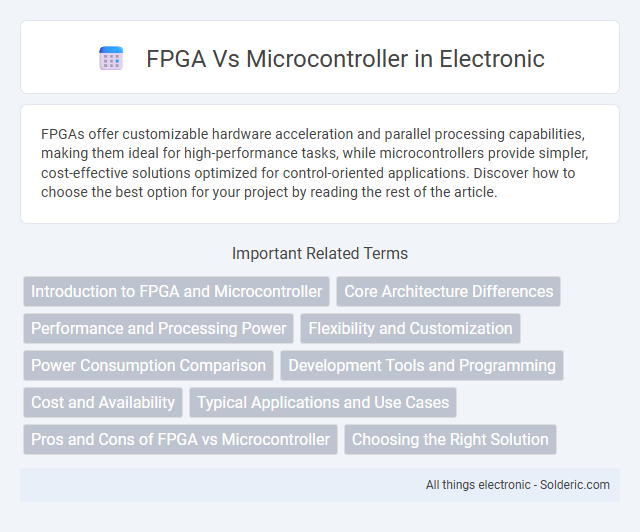FPGAs offer customizable hardware acceleration and parallel processing capabilities, making them ideal for high-performance tasks, while microcontrollers provide simpler, cost-effective solutions optimized for control-oriented applications. Discover how to choose the best option for your project by reading the rest of the article.
Comparison Table
| Feature | FPGA | Microcontroller |
|---|---|---|
| Architecture | Reconfigurable hardware logic | Fixed hardware with integrated CPU |
| Performance | High parallel processing, low latency | Sequential processing, moderate speed |
| Flexibility | Custom hardware design via HDL | Predefined instruction set |
| Power Consumption | Higher power usage | Low power, energy efficient |
| Development Complexity | Complex, requires hardware design skills | Simpler, software programming |
| Cost | Higher unit cost | Lower unit cost |
| Use Case | High-speed data processing, custom hardware acceleration | Embedded control, IoT devices |
Introduction to FPGA and Microcontroller
Field-Programmable Gate Arrays (FPGAs) are integrated circuits that can be configured by the user to perform complex hardware-level functions, offering parallel processing and high flexibility. Microcontrollers are compact integrated circuits designed for specific control applications, combining a processor core, memory, and peripherals in a single chip for real-time embedded systems. FPGAs excel in customizable hardware acceleration tasks, while microcontrollers provide efficient, cost-effective solutions for sequential and control-oriented programming.
Core Architecture Differences
FPGA core architecture consists of a vast array of programmable logic blocks and interconnects, enabling highly parallel processing and customization at the hardware level. Microcontrollers feature fixed-function cores with integrated peripherals optimized for sequential control tasks and low-power operation. Your choice between FPGA and microcontroller depends on whether you require hardware adaptability and concurrency or simplicity and energy efficiency.
Performance and Processing Power
FPGA offers superior performance and processing power due to its parallel architecture, enabling simultaneous execution of multiple tasks, which significantly accelerates data processing compared to microcontrollers. Microcontrollers typically operate with sequential processing and fixed clock speeds, limiting their ability to handle complex computations quickly. Your choice depends on whether you need the FPGA's high-speed customization or the microcontroller's simplicity and low power consumption.
Flexibility and Customization
FPGAs offer unparalleled flexibility with their reconfigurable architecture, allowing you to customize hardware logic to meet specific application needs, unlike microcontrollers which rely on fixed hardware and predefined instruction sets. This configurability enables FPGAs to perform parallel processing tasks efficiently, adapting to various protocols and data formats in real-time. Microcontrollers provide ease of use and simpler programming but lack the hardware-level customization and scalability that FPGAs deliver for complex and high-performance applications.
Power Consumption Comparison
FPGA power consumption varies significantly based on design complexity and operational frequency, often higher than microcontrollers in similar tasks due to parallel processing capabilities. Microcontrollers typically offer lower power consumption by executing sequential instructions with simpler hardware architectures, ideal for battery-powered or energy-constrained applications. Your choice between FPGA and microcontroller will depend on balancing performance needs with the acceptable power budget for your project.
Development Tools and Programming
FPGA development tools like Xilinx Vivado and Intel Quartus provide hardware description languages such as VHDL and Verilog, enabling parallel processing and custom hardware logic design. Microcontroller programming relies on integrated development environments (IDEs) like Arduino or MPLAB that support C/C++ languages for sequential task execution and simpler debugging. Your choice depends on whether you need fine-grained hardware control with FPGAs or straightforward software development with microcontrollers.
Cost and Availability
FPGA devices typically have a higher upfront cost compared to microcontrollers due to their complex architecture and reconfigurability, making microcontrollers a more cost-effective choice for low-volume or simpler applications. Microcontrollers are widely available and come in numerous varieties with integrated peripherals, ensuring easier procurement and faster time-to-market for embedded systems. Your decision between FPGA and microcontroller should consider budget constraints and the availability of specific components to optimize overall project costs.
Typical Applications and Use Cases
FPGAs excel in applications requiring high parallel processing, real-time signal processing, and complex algorithm acceleration such as telecommunications, aerospace, and video processing. Microcontrollers are preferred for embedded control tasks, sensor interfacing, and low-power IoT devices, where cost-efficiency and ease of programming are critical. Industrial automation, automotive engine control, and consumer electronics commonly utilize microcontrollers for their predictable behavior and integrated peripherals.
Pros and Cons of FPGA vs Microcontroller
FPGAs offer high parallel processing capabilities and customizable hardware logic, enabling superior performance for complex, timing-sensitive applications, but they require specialized knowledge and longer development times. Microcontrollers provide ease of programming, low power consumption, and cost-effectiveness for simple or repetitive tasks, though they lack the flexibility and speed of hardware-level customization found in FPGAs. Choosing between an FPGA or a microcontroller depends on your project's requirements for performance, complexity, and development resources.
Choosing the Right Solution
Selecting between FPGA and microcontroller depends on your project's complexity and performance requirements. FPGAs offer parallel processing and customizable hardware, ideal for high-speed, real-time applications, while microcontrollers excel in simpler, cost-effective control tasks with lower power consumption. Understanding your system's timing, flexibility, and scalability needs ensures the right solution for optimal efficiency and development time.
FPGA vs Microcontroller Infographic

 solderic.com
solderic.com